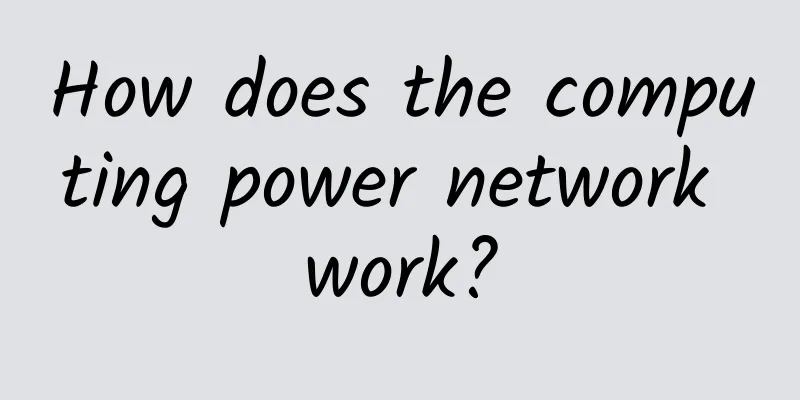How does the computing power network work?

|
In the previous articles, I gave you a detailed introduction to the nature of computing power and computing power network. Today, in the last article of the computing power series, we will take a closer look at the networking architecture and technical system of the computing power network. The architecture of the computing networkI mentioned before that the role of the computing network is to provide computing resource services to users. It completely "integrates" computing resources into the communication network and provides computing resource services that best meet user needs in a more holistic form. This is a highly flexible and intelligent network. The core feature of the computing network is that it uses computing power to achieve comprehensive control of computing resources and network resources, allowing the network to perceive the user's computing power needs and its own computing power status in real time. After analysis, the computing network can dispatch computing power resources of different locations and types to serve users. We can think of it as a "universal faucet". It can always provide water flow with appropriate strength, temperature and pH according to your needs, giving you the best water experience. So, we are naturally curious about what kind of "water network" is behind this "universal faucet"? How does it control and dispatch resources? Next, let’s take a look at the architecture of the computing power network. First of all, I need to explain in advance that the computing network is still a research technology and has not been fully finalized. Therefore, what I provide below is only the computing network architecture (concept) diagram of each operator and equipment manufacturer, and there will be certain differences between them. Moreover, it is very likely to change in the future, please be aware of this. The following are some representative computing network architecture (concepts) of operators and equipment manufacturers: China Mobile (from the Computing Network Technology White Paper, 2022) China Mobile (from the Computing Network White Paper) China Unicom (from Huawei WIN-WIN Innovation Week, 2022) China Unicom's computing power network architecture (from the White Paper on Computing Power Network Architecture and Technology System) China Telecom Cloud Network Integration Target Technology Architecture (From the "Cloud Network Integration 2030 Technology White Paper") Huawei (from Huawei WIN-WIN Innovation Week, 2022) These diagrams are a bit complicated, I believe that you may not understand them. I will draw a simple diagram, you should be able to understand it: In simple terms, it is the hierarchical thinking of information communication. If you look at it in terms of levels, you can sort out your thoughts. In order to reduce the pressure of reading, you can first pass the green and low-carbon and safety protection on the right. Let’s look at it from the bottom up, layer by layer. Computing Network InfrastructureThe bottom layer of the computing network is still the computing network infrastructure layer, which is inevitable. In the computing network, the infrastructure is no longer just computing resources (CPU, storage, GPU, etc.), but also includes network resources. On the computing power resource side, the integration of computing power infrastructure is still centered on cloud technology, including cloud native, virtualization, containers, etc. Here, some underlying new technological innovations related to computing power are also worth paying attention to, such as heterogeneous computing, serverless computing, storage-computing integration, and computing power offloading. You can ignore them for now and introduce them in a special topic later. In the previous articles, we introduced the changes in the network under the trend of cloud-network integration. To put it in one sentence, it is to make the closed network more open (decoupling), making it like a computer, and it can be "commanded" through software (software-defined). The bottom layer of the network (physical layer, data link layer), on the transmission network side, is still optical (only optical can guarantee basic hard indicators such as communication bandwidth and capacity). The optical bottom layer technologies, such as OTN, OXC, ROADM, C+L band, 400G/800G, etc., are still the same, with no difference. On the access network side, 5G NR, PON (50G-PON), there is nothing special (except that edge computing power will have some relationship). The big changes are in the upper layer of the network. We will talk about it later. Computing and Network Integration (Computing Resource Management, Network Resource Management)Going up further, things start to get different. Because the computing network needs to schedule computing power and network resources, it needs to "pre-process" and "connect" the resources. (This layer is actually classified as the orchestration management layer in many architectures. I think it will be easier to understand if I take it out separately.) At this layer, the most noteworthy thing is computing power routing. The biggest difference between computing power networks and traditional networks lies in their three major characteristics. The first major characteristic is computing power routing. Before computing power, let's talk about computing power perception. Computing power perception is the network's comprehensive perception of the deployment location, real-time status, load information, and business needs of computing power resources and computing power services. China Mobile's computing power perception network white paper is analyzed from the perspective of computing power perception. The architecture of the computing power perception network (from China Mobile's "Computing Power Perception Network CAN Technology White Paper 2021") On the one hand, each computing power node will uniformly publish the computing network information measurement model, and the network will aggregate the computing network information reported by multiple nodes to build a global unified computing network status view. On the other hand, the network completes the unified analysis of the business computing network needs, realizes comprehensive perception of the business, and provides guarantees for computing power scheduling based on business needs. Computing power status perception and notification (from "Computing Power Awareness Network CAN Technology White Paper 2021") To put it bluntly, the purpose of computing power perception is to find out how many resources are on hand and what the users' needs are. The objects of perception must be measured and identified. Hence, there are computing power measurement and computing power identification. Operators currently attach great importance to these two areas. There is diversity in computing power, and there are also heterogeneous hardware chips, so there is no unified measurement system and standard. This will cause trouble in establishing a unified computing power model. It’s very simple. The measurement units are different. How to evaluate and bill computing power? The computing power identification is equivalent to the computing power ID card. Users indicate the required services through the computing power identification, and the network obtains information such as the target computing power service and computing power demand by parsing the computing power identification, providing a basis for computing power scheduling, etc. This computing power identification must be globally unified and verifiable. Okay, next is computing power routing. In the China Mobile computing power-aware network architecture diagram, in addition to the computing power resource layer, a computing power routing layer is also separately drawn. The computing power routing layer is the core functional layer of the computing power-aware network. It supports the perception and notification of multi-dimensional resources and services such as network, computing, and storage, and realizes the joint scheduling of "network + computing". The computing power routing layer, including computing power routing control technology and computing power routing forwarding technology, realizes the on-demand scheduling of business requests at the routing layer. When talking about computing power routing, we must talk about CFN (Computing First Networking). CFN is sometimes used to refer to the entire computing network in a broad sense. However, here, CFN is a distributed routing protocol that schedules and balances computing power on demand between different edge clouds. CFN technical architecture (from the "Computing Power Aware Network Technology White Paper") CFN is actually very interesting. The traditional understanding of routing is the routing of data packets. The routing here in CFN is to publish the computing resource status and network resource status as routing information to the network. Then, the network routes the computing task message to the most appropriate computing node based on the virtual service ID. At present, the CFN protocol mainly carries computing power information in the form of extended byte information in the BGP message header of the service route, and spreads the load status of computing nodes in the network to the entire network in real time. Obviously, computing power routing and CFN are the prerequisites for computing power scheduling at the upper layer. Orchestration ManagementGoing up, there is the core key part of the computing network - orchestration management. Students who have worked on the core network NFV (network element function virtualization) must be very familiar with orchestration. In the NFV architecture, there is orchestration. This is a very interesting word, which means "recruiting and arranging" you. To put it bluntly, it is complete control and scheduling. The second major feature of the computing network is computing power scheduling. Computing power scheduling is to perform intelligent orchestration and elastic scheduling of computing power resources in the entire network based on the computing network brain. More specifically, it is: completing computing power operation and computing power service orchestration, completing the management of computing power resources and network resources, including the perception, measurement and OAM management of computing power resources; realizing computing network operation for end users, and the management of computing power routing layer and network resource layer. After the computing power resources are perceived, identified and perceived, in order to manage them, there is also a logical process of computing power resource management (also separately called: computing power management layer). It mainly includes computing power registration, computing power OAM (performance monitoring, fault management), and computing power operation (billing management, service contract, etc.). Computing power management layer (From "Computing Power Perception Network CAN Technology White Paper 2021") This functional division is very troublesome. In some operators' architecture diagrams, this layer is defined as the computing power management layer and exists separately. In some architecture diagrams, this layer does not exist and is included in the orchestration management layer. Therefore, everyone has different understandings and it is very confusing. Anyway, everyone should know that there is such a functional group. To achieve this, a "nerve center" that controls the network is definitely needed. The core control part of the scheduling and orchestration of the computing power network is called the "computing network brain" by some operators. This "network brain" has four important functions:
The computing network management and orchestration layer maintains global static computing power, services, and network topology information, and synchronizes it to each entry computing power routing node. The computing power routing node maintains the topology information of the computing power service and the real-time status information of computing power resources and network resources, and performs computing network collaborative scheduling through distributed computing power routing nodes. The "computing network brain" is the nerve center of the computing network, coordinating global resources, and its importance is self-evident. It goes without saying that AI is introduced into the "computing network brain". In addition to AI, operators and equipment manufacturers now also plan to add "digital twins" and "intention engines" to it, striving to improve the intelligence level of the "computing network brain". To be honest, after carefully looking at the management and orchestration layer, I have a feeling that the computing network is an upgrade and integration of SDN and NFV technologies. The shadows of these two technologies are everywhere. However, many other technologies are added to the surface to form a more complete and larger system. Service OperationIs there nothing above the computing power brain? No, don’t forget, we also have the service operation layer. To put it simply, the service operation layer provides an interface for upper-layer applications to control the computing network. The computing network brain is not the real boss, but just a "big housekeeper". The real network control is by upper-layer users and applications. The purpose of the service operation layer is to provide computing power network capabilities to the upper layer. Key technologies include: computing power trading, computing power networking, computing power packaging, and intent perception. The third major feature of the computing power network is computing power trading. Routing, scheduling, and trading are the three major characteristics of computing power networks Computing power trading is an important innovation of the computing power network. Before computing power and the network were integrated, users paid whoever's cloud computing they used and whoever's communication network they used. After computing power and the network were integrated, computing power was everywhere, and it was dispatched back and forth. Who should you pay? Computing power trading is designed to solve this problem. In the computing power trading scenario, there will be a trusted ubiquitous computing power trading platform. From "Computing Network - Network Architecture and Key Technologies in the Era of Cloud-Network Integration 2.0" The general process is as follows: First, the computing power consumer puts forward detailed computing power requirements. Then, the computing power trading platform integrates the available resources according to the requirements and generates a computing power network resource table. According to factors such as latency and cost, there will be corresponding quotations. Next, the computing power consumer chooses a "package" that best suits him according to the resource table. Then, a transaction contract is signed on the computing power trading platform. Then, the trading platform dispatches resources through the computing power network according to the contract and updates resource information. Finally, the contract ends, the service is terminated, and the resources are released. Computing power network trading platform (From "Integrating Multi-party Computing Power Networks to Achieve Optimal Computing Resource Utilization", Lei Bo) In the 21st century, whenever we talk about transaction models, we will definitely involve a word - blockchain. Yes, that's right. The computing power trading platform also uses blockchain technology to realize functions such as distributed ledgers and anonymous transactions. In summary, the computing power network closely revolves around the computing power needs of users, covering the entire life cycle of computing power generation, scheduling, trading, and consumption. What the computing power network wants to achieve is that computing follows people and computing follows "demand", achieving the ultimate perfect match between computing power supply and demand, without any compromise or waste. Standard Progress of Hash Power NetworkIn recent years, computing power networks have become very popular in China. Both operators and equipment manufacturers attach great importance to this concept. Domestic operators in particular are simply fanatical about computing power networks. The reason is very simple. Foreign operators rarely touch the Internet. They basically only deal with communications, and at most, they deal with cloudification of traditional communications. Domestic operators, on the other hand, have both Internet and cloud, and they particularly hope to integrate and activate the resources of Internet and cloud. Moreover, our country attaches great importance to infrastructure construction. Computing network is an important digital infrastructure. Therefore, as state-owned enterprises, operators also attach great importance to accumulation in this area. On the one hand, in order to seize the initiative in technical standards, and on the other hand, for brand promotion and image building, the three major operators have begun to roll up their computing power network. 2019 is recognized as the first year of computing power network. On November 1 of this year, China Unicom took the lead and released the "China Unicom Computing Power Network White Paper" during the Beijing PT Exhibition. This is the first white paper related to computing power network in China. Since then, domestic operators have rushed to release a number of white papers and actively promoted the formulation of standards for computing power networks. In terms of standard promotion, I compiled a table based on online information, which roughly records the situation of major standard organizations in the formulation of computing power network standards, for reference only: Comprehensive from CITIC Securities, major white papers, official website news Trial progress: From CITIC Securities ConclusionFrom a practical point of view, computing power network is still a long way away from us. At present, we are in the progress stage of cloud-network integration, and computing network integration or computing power network is still under research. Nevertheless, there is no doubt that computing power network is the future development trend of computing power and connection power. The integration of computing and network is inevitable and is also the destination of the entire communications industry. Traditional communications, as a "pipeline", cannot enhance their own value. The best way out is to fully embrace the cloud. |
<<: 5G Ready: Enabling Technology to Prepare for the Future of Work
>>: One of the biggest features of 5G is the security minefield
Recommend
All IPV4 addresses are exhausted, and you still don’t know what it is?
On November 26, 2019, the last IPv4 address in th...
Megalayer: Hong Kong/Philippines/USA/Singapore special VPS starting at 199 yuan per year, native IP starting at 249 yuan per year
Megalayer promotional VPS packages are being rest...
Deep dive into the Kubernetes network model and network communication
Kubernetes defines a simple and consistent networ...
Report: Amazon, Microsoft and Google account for half of all major hyperscale data centers
Amazon, Microsoft and Google account for more tha...
Basic concepts and development prospects of Bluetooth Mesh protocol
Each device node in the Mesh network can send and...
Buying a ticket can cause a loss of 100,000 yuan. This is the black market you don’t know about.
Recently, Damai.com was attacked by a database co...
Ministry of Industry and Information Technology: By the end of 2021, more than 600,000 new 5G base stations will be built and more than 20 gigabit cities will be built
[[390193]] On March 24, the Ministry of Industry ...
An article on HTTP and TCP protocols
[[397802]] This article is reprinted from the WeC...
DMIT: Hong Kong CN2 GIA line $298.8/year-2GB/40G SSD/500GB@300Mbps/optional quarterly payment
DMIT.io is a foreign hosting company founded in 2...
Aruba and Digital China work together to build a smart campus project
On September 19, during the Atmosphere 2017 confe...
Virtono: 25% off San Jose VPS starting at 2.2 Euros per month, free double memory
Virtono is a foreign VPS hosting company founded ...
The biggest risk of 5G networks
The fifth generation (5G) network has the potenti...
Interpretation of the 2020 financial reports of the three major operators: revenue and profits exceeded expectations, and the value of 5G is in the ascendant
Recently, the three major operators released thei...
A leap from concept to practice! How does the cloud's native "immune system" fight organically?
On July 16, the Alibaba Cloud Native Security Onl...
Six good habits and 23 lessons that Linux operation and maintenance must know to avoid pitfalls!
I have been engaged in operation and maintenance ...









